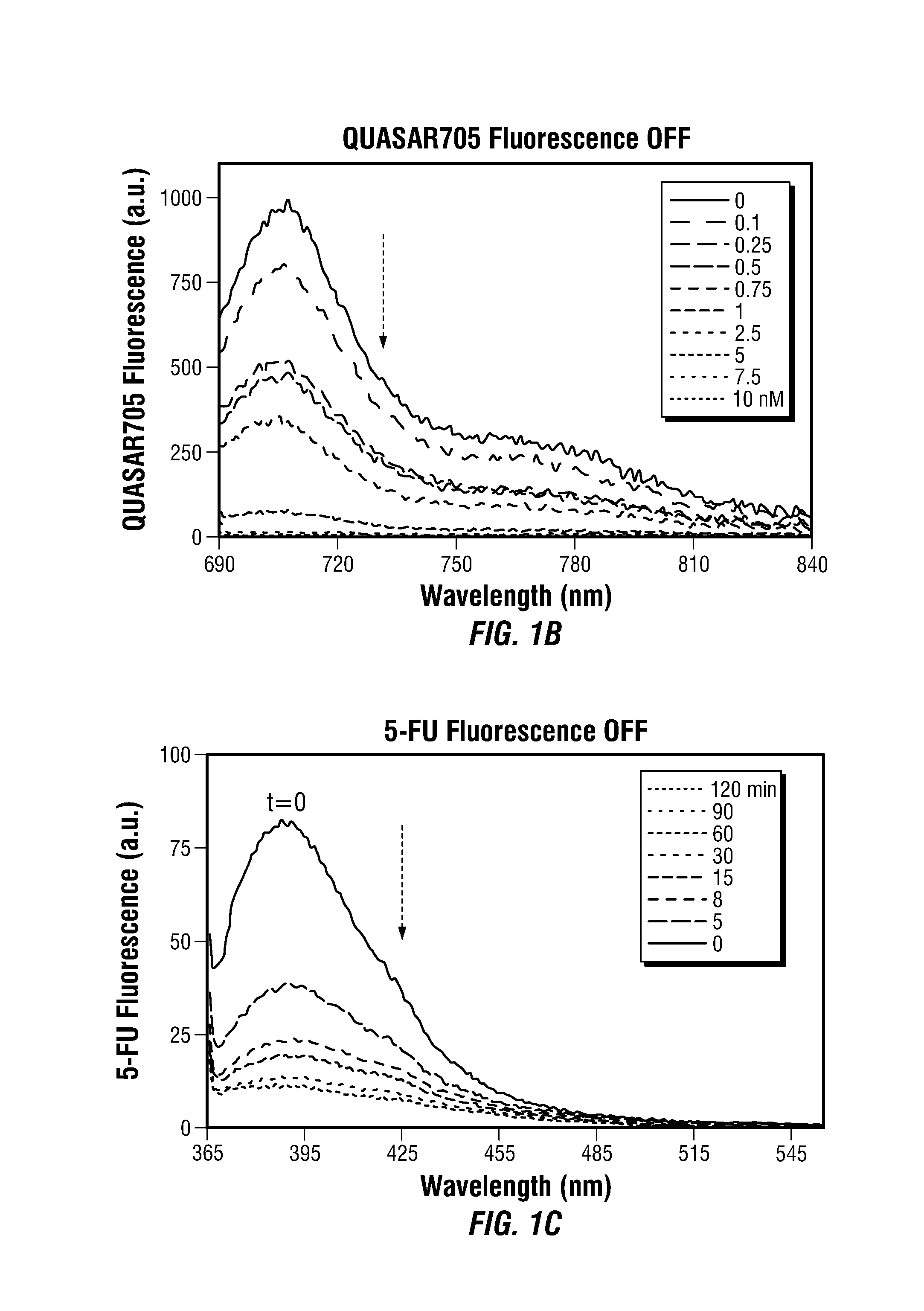Theranostic Nanoprobes for Overcoming Cancer Multidrug Resistance and Methods
a multi-drug resistance and cancer technology, applied in the field oftheranostic nanoprobes for overcoming cancer multi-drug resistance and methods, can solve the problems of limiting the success of chemotherapy, cytotoxicity and cell death, and the overall response to this drug remains only 15%
- Summary
- Abstract
- Description
- Claims
- Application Information
AI Technical Summary
Benefits of technology
Problems solved by technology
Method used
Image
Examples
example 1
Synthesis of Bare-Gold Nanoparticles
[0118]Gold nanoparticles were synthesized by a citrate reduction method, which is well-known in the art, e.g., see Lee, P. C. et al., J. PHYS. CHEM. 1982, 86(17), 3391-3395.
[0119]The gold nanoparticles produced by the methods of this example had an average diameter of 13.8±3.4 nm.
[0120]In the first step, 225 mL of 1 mM hydrogen tetrachloroaureate (III) hydrate (Sigma-Aldrich, USA)(88.61 mg) was combined with 500 mL of distilled water, heated, and stirred under reflux. When boiling began, 25 mL of 38.8 mM sodium citrate dihydrate (Sigma-Aldrich, USA)(285 mg) was added, which resulted in a red solution. The solution was kept under ebullition with vigorous stirring, and protected from light for 30 minutes. The solution was then cooled down, and still protected from light.
[0121]The resulting bare-gold nanoparticles were characterized by Transmission Electron Microscopy (TEM) and UV-Vis molecular absorption spectra.
example 2
Synthesis of PEGylated-Gold Nanoparticles
[0122]PEGylated-gold nanoparticles were produced in this example with commercial hetero-functional PEG, specifically a α-Mercapto-ω-carboxy PEG solution (HS—C2H4—CONH-PEG-O—C3H6—COOH)(3500 Da)(Sigma-Aldrich, USA)(see, e.g., Sanz, V., et al., JOURNAL OF NANOPARTICLE RESEARCH, 2012, 14, and Conde, J. et al. ACS NANO, 2012, 6, 8316-8324). The PEGylated-gold nanoparticles produced by this example were functionalized with a 30% saturated surface of the α-Mercapto-ω-carboxy PEG.
[0123]Not wishing to be bound by any particular theory, it is believed that the 30% of saturated PEG layer allowed the incorporation of additional thiolated components, such as the thiolated DNA-hairpin-Quasar 705 nm, and the thiolated-oligo-BHQ2 quencher.
[0124]In this example, 10 nM of the bare-gold nanoparticles of Example 1 were dispersed in an aqueous solution of 0.01×PBS (Cytodiagnostics, Ontario, Canada), and then combined with 0.0006 mg / mL of the commercial hetero-fun...
example 3
Synthesis of Dark-Gold Nanobeacons
[0130]Three different sequences of gold nanobeacons were prepared by the methods of this example: (1) a nanobeacon anti-MRP1, which detected and inhibited MRP1 mRNA, (2) a nanobeacon anti-Luc, which hybridized with luciferase mRNA and released a drug, however, did not target MRP1, and (3) a nanobeacon nonsense, which was designed not to hybridize with any target within the genome).
[0131]Therefore, in addition to designing an anti-MRP1 nanobeacon that detected and inhibited MRP1 mRNA, anti-Luc nanobeacons (which hybridized with luciferase mRNA and released the drug without targeting MRP1), and nonsense nanobeacons (which did not hybridize with any target) were developed as controls for this example.
[0132]The thiol-DNA-hairpin Quasar® 705 sequences are shown in the following table:
Oligomers sequences used in dark-gold nanobeaconsassembly.OligomersSequence and modificationsnanobeaconThiol- 5′tttgcatGGCTACATTCAGATGACACanti-MRP1atgcaaa 3′ -Q705nanobeacon...
PUM
| Property | Measurement | Unit |
|---|---|---|
| diameter | aaaaa | aaaaa |
| molecular weight | aaaaa | aaaaa |
| diameter | aaaaa | aaaaa |
Abstract
Description
Claims
Application Information
 Login to View More
Login to View More - R&D Engineer
- R&D Manager
- IP Professional
- Industry Leading Data Capabilities
- Powerful AI technology
- Patent DNA Extraction
Browse by: Latest US Patents, China's latest patents, Technical Efficacy Thesaurus, Application Domain, Technology Topic, Popular Technical Reports.
© 2024 PatSnap. All rights reserved.Legal|Privacy policy|Modern Slavery Act Transparency Statement|Sitemap|About US| Contact US: help@patsnap.com










